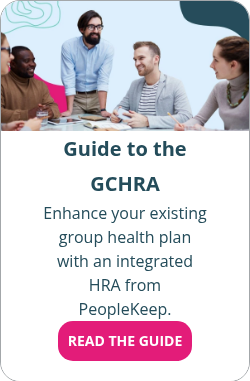Is an integrated HRA right for my organization?
By Elizabeth Walker on October 27, 2023 at 12:00 PM
Many business owners offer a traditional group health plan to help with employee recruitment and retention efforts. But, due to rising healthcare costs, it can be challenging to find a group policy that offers an affordable premium and doesn’t come with a high deductible.
If you’re trying to save on monthly premium costs while offering your employees a robust health benefit, an integrated health reimbursement arrangement (HRA) may be the solution.
With an integrated HRA, you can offer a more cost-effective employer-sponsored group plan while making your employees’ overall health benefit more valuable. But as with any employee benefit, knowing how an integrated HRA can meet your needs is essential before implementing one at your company.
In this blog, we’ll define integrated HRAs and go over four key factors to consider when determining if this health benefit is right for your business.
What is an HRA?
Before we dive into integrated HRAs, let’s briefly review how an HRA works.
An HRA is an account-based group health plan employers use to reimburse employees tax-free for out-of-pocket medical expenses listed in IRS Publication 502 and, sometimes, individual health insurance premiums. Unlike health savings accounts (HSA), which allow for employer and employee contributions, HRAs are entirely employer-funded.
HRA coverage isn't medical insurance. Instead, it’s a way for you to fund the health products and services your employees select. You choose a monthly allowance that works for your company’s budget, and your employees use that allowance toward qualifying medical services and items. Once an employee incurs an eligible medical care expense and you verify and approve the cost, you reimburse them up to the allowance amount.
HRA funds stay with you until you reimburse an employee. Additionally, if an employee leaves your organization and has unused funds, those funds remain with your company.
Lastly, HRA reimbursements are tax-deductible and payroll tax-free for employers. They are also payroll tax-free and free of income taxes for employees as long as their health insurance policy meets minimum essential coverage (MEC).
What is an integrated HRA?
Some HRAs work with individual coverage. However, integrated HRAs are so-named because they specifically integrate with group health plan coverage. With this HRA, employers of any size can supplement their group health insurance by offering a reimbursable allowance to employees to pay for medical care expenses their health plan doesn’t fully cover, like deductibles and copays.
Like with other types of HRAs, you choose a monthly allowance for your employees to use on healthcare. While some integrated HRAs, like the excepted benefit HRA, have annual limits, the integrated HRA that PeopleKeep offers—a group coverage HRA (GCHRA)—has no maximum contribution caps. So you can offer as much allowance as your budget allows.
While many employers offer an integrated HRA alongside a high-deductible health plan (HDHP), you can choose any group health coverage that works best for your organization and employees, including a low-deductible policy.
Choosing a GCHRA over other integrated HRA options, like an excepted benefit HRA, gives employers extra flexibility. If you choose to offer an integrated HRA through a solution like PeopleKeep, you don’t have to select compatible group health insurance coverage via a specific carrier. You can also keep the same GCHRA even if you switch group insurance companies.
Now that you know more about integrated HRAs, let’s review the four things you must consider when deciding if an integrated HRA is right for you and your employees.
1. You have a group health insurance plan
If you’re considering an integrated HRA, you must have a group health insurance plan—employees can’t have only individual health coverage. Specifically, the Affordable Care Act’s (ACA) employer mandate requires you to integrate your HRA with ACA-compliant group health coverage that meets MEC.
If you don’t follow the integration requirements, your HRA will be out of compliance and subject to penalties, like employer payment plans.
Keep in mind that only active employees enrolled in your employer-sponsored group health plan can participate in an integrated HRA. For example, suppose you have current employees with individual coverage or who are on their spouse’s insurance plan instead of your group plan. In that case, they aren’t eligible to receive HRA reimbursements.
A critical difference between a GCHRA and other HRAs, like a qualified small employer HRA (QSEHRA) or individual coverage HRA (ICHRA), is that you can’t reimburse eligible participants for their individual or group health insurance premiums. This is because employees pay for group health insurance premiums with pre-tax payroll deductions. So, the IRS considers tax-free premium reimbursements to be “double dipping” on the tax advantages.
However, plan participants can save on other eligible medical care expenses with their HRA.
2. You’re looking to reduce healthcare costs
Surging group health insurance prices can make it challenging for businesses to care for their employees. Fortunately, switching to an HDHP can help you achieve significant savings, and pairing the plan with an integrated HRA allows you to provide a more compelling benefit.
You aren’t required to have an HDHP with an integrated HRA, but it has a significant advantage. HDHPs offer more affordable coverage than other plans in exchange for higher deductibles. Because integrated HRAs have no annual limits, you can improve HDHP coverage for your employees by offering reimbursements.
For employers looking to be extra budget-conscious, integrated HRAs provide additional cost-control options. Employers can establish their own special rules in their plan documents regarding minimum deductibles, cost-sharing, or even the medical care expenses your HRA can reimburse.
A few ways you can control costs with an integrated HRA include:
- You can limit reimbursement requests by requiring an explanation of benefits (EOB) for medical care expenses.
- You can require your active employees to pay a deductible, coinsurance, and copays (separate from those in the group plan) before receiving reimbursement.
- You can reimburse your employees for only a certain percentage of their eligible expenses.
These additional rules can help employers take greater charge of their budget while allowing their employees to enjoy the affordable premium of an HDHP, paired with tax-free reimbursements for their medical expenses.
3. You want to attract and retain top talent
Aside from salary, health benefits are the top consideration applicants consider before accepting a job offer. Once you get them in the door, you need a strong employee retention strategy to encourage them to stay. That’s why having a robust health benefit is important—it’s one way to ensure employee satisfaction, attract talented candidates, and increase retention.
If you have extra money to spend on health benefits, adding an integrated HRA to a generous employee benefit package can help you better attract and retain key talent. All types of HRAs offer substantial flexibility. Each employee can choose what healthcare items and services they want to use their benefit toward and can have greater financial stability with the support of their HRA reimbursements.
A Gallup survey1 found that 38% of American adults put off necessary medical care in 2022 due to cost. Offering an integrated HRA to cover out-of-pocket costs can encourage your team to prioritize their health and show that you care about their well-being.
As quality employees increasingly expect great benefits packages, an integrated HRA is a great way to persuade candidates to accept your job offer and stay with your company for the long run.
4. You want to customize your health benefit
An integrated HRA is entirely customizable for your business, from requiring an EOB to setting your allowance. But for further personalization, consider setting up unique classes of employees to get even more bang for your buck.
Employee classes divide workers into groups based on legitimate job-based criteria, such as full- and part-time status. You can offer employees in different classes different HRA amounts and implement cost-sharing requirements for a customized benefit.
With an integrated HRA, you can divide your employees into the following seven permissible classes:
- Full-time employees: You can choose whether a full-time employee at your organization works an average of 30 hours or more per week or 40 hours or more each week.
- Part-time employees: You can choose whether a part-time employee at your organization works an average of less than 40 hours or less than 30 hours a week.
- Salaried: Salaried employees are workers you pay on an annual basis who are typically exempt from overtime pay.
- Hourly: Hourly employees are those you pay on an hourly basis who are typically eligible for overtime pay.
- Manager: These are employees who are in management-level positions.
- Executive: These are employees who are in executive-level positions.
- Staff: These are employees who aren't in leadership positions.
The ways you can use employee classes to your benefit are endless. For example, you can lower premium costs by removing hourly employees from your group health plan coverage. Instead, you can offer them an allowance through an ICHRA or health stipend to buy individual health coverage.
Or, you can celebrate your executive-level employees by providing them with a larger allowance than your other staff members.
Within each class of employees, you can vary allowance amounts by the employee’s age and family status. If you choose to vary by age, you can offer an allowance to the oldest employees in a class up to three times higher than those offered to the youngest employees in the same class. You can’t provide younger employees with more allowance than their older employees.
Outside of age and family status, you must offer the GCHRA to each employee in the same class on the same terms.
Determining allowance amounts by employee classes is optional. But they can work to your advantage if you want to personalize your health benefits while using your budget to its fullest potential.
Conclusion
To maximize any account-based group health plan, like an HRA, you must choose the right one for you and your employees. If you have group health plan coverage, a customizable integrated HRA helps control costs and attract talent by allowing you to design a health benefit that meets your business’s needs.
PeopleKeep’s integrated HRA can provide an all-in-one solution to boost your traditional group health plan. And with our HRA administration software, we’ll help you manage your health benefit in just minutes each month.
This article was originally published on July 2, 2020. It was last updated on October 27, 2023.
Check out more resources
See these related articles

How to grow your insurance book of business with an HRA
Want to take your insurance book of business to the next level? Explore the power of an HRA and learn how to leverage it for quicker growth in this guide.

Which health reimbursement arrangement is right for your client?
Unsure about which HRA is best for your client? This guide breaks down the different HRA options to help you make an informed decision.

What is healthcare reimbursement?
Looking to reimburse your employees for their healthcare expenses? Learn everything you need to know about healthcare reimbursement.



